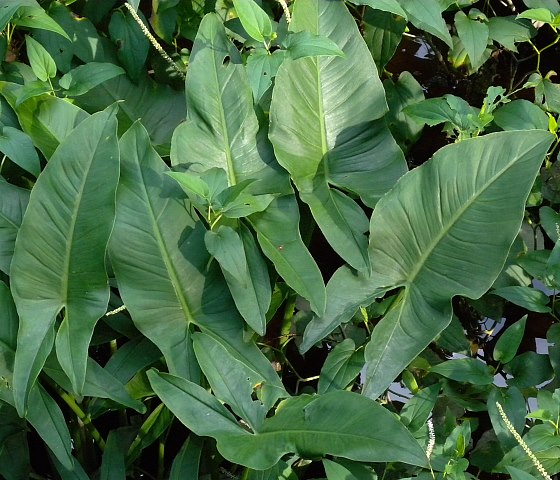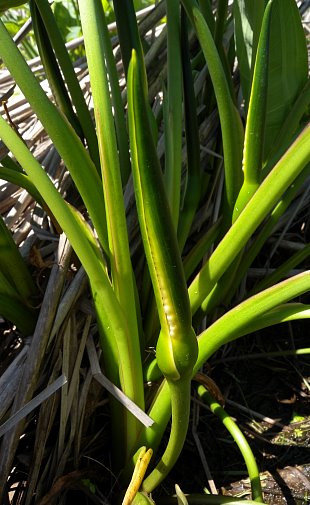
The blooming period occurs from late spring to early summer for about 2-3 weeks. Afterwards, the lower portion of the spadix develops an ovoid cluster of berries, while rest of the spadix rots away. As the berries become mature, the peduncle bends downward, inserting the berries into the water. The tip of the spathe drills into the underlying muck, releasing some of the berries. The released berries have the capacity to float on water, thereby distributing the seeds into new areas. Each globoid berry is about ½" across; the skin of the berry varies in color from green to brown, while its interior contains clear mucilage and 1-3 chunky seeds. The root system consists of stout vertical rootstalks and fleshy fibrous roots; as the root mass expands, vegetative offsets are formed. This plant often forms colonies of varying size.
Cultivation: The preference is partial sun to light shade, standing water up to 1' deep, and muck containing organic matter, sand, or peat. This plant is bothered by very few disease organisms and insect pests.
 Range
& Habitat: Arrow Arum is occasional in southern
Illinois, NE
Illinois, and the central section of the state along the Illinois
river; it is rare or absent elsewhere (see Distribution
Map).
Habitats include swamps, shallow
water along ponds, bottoms of slow-moving shallow rivers, and ditches.
Arrow Arum is typically found in shaded or
partially shaded areas of
wetlands, rather than in open sunny areas.
Range
& Habitat: Arrow Arum is occasional in southern
Illinois, NE
Illinois, and the central section of the state along the Illinois
river; it is rare or absent elsewhere (see Distribution
Map).
Habitats include swamps, shallow
water along ponds, bottoms of slow-moving shallow rivers, and ditches.
Arrow Arum is typically found in shaded or
partially shaded areas of
wetlands, rather than in open sunny areas.Faunal Associations: The unusual inflorescence produces an odor that attracts flies. The primary pollinator of the flowers is the Chloropid fly, Elachiptera formosa (Patt et al., 1995). This fly lays its eggs on specialized tissues of the spadix, and cross-pollinates the flowers while wandering from inflorescence to inflorescence. The adults feed on pollen. Other visitors of the flowers include a Syrphid fly, Helophilus sp., and a fruit fly, Drosophila subpalustris; the adults of these flies also feed on pollen. Two semi-aquatic leaf beetles, Donacia tuberculata and Plateumaris shoemakeri, feed on the foliage of Arrow Arum (Clark et al., 2004). The berries are eaten by the Wood Duck, Mallard, and King Rail; these birds probably spread the seeds into new areas. There is also some evidence that the Snapping Turtle (Chelydra serpentina) and Midwestern Painted Turtle (Chrysemys picta marginata) use Arrow Arum as a food source (Lagler, 1943). Mammalian herbivores avoid consumption of this plant because of its toxicity: both the roots and foliage contain crystals of calcium oxalate that can cause severe irritation of the gastrointestinal tract and kidney failure.
Photographic Location: Bottom of a shallow river at the Indiana Dunes State Park in NW Indiana, and along a roadside near Cowle's Bog at the Indiana Dunes National Lakeshore in NW Indiana.
Comments: The leaves of Arrow Arum superficially resemble those of another wetland plant, Sagittaria latifolia (Common Arrowhead). While the leaves of Arrow Arum have pinnate venation (e.g., a central vein with lateral veins), the leaves of Common Arrowhead have palmate venation (even though many of these veins appear to be parallel). Common Arrowhead also produces a narrow raceme of showy white flowers with 3 petals, which has a very different appearance from the inflorescence of Arrow Arum. Another common name of Peltandra virginica is Tuckahoe.